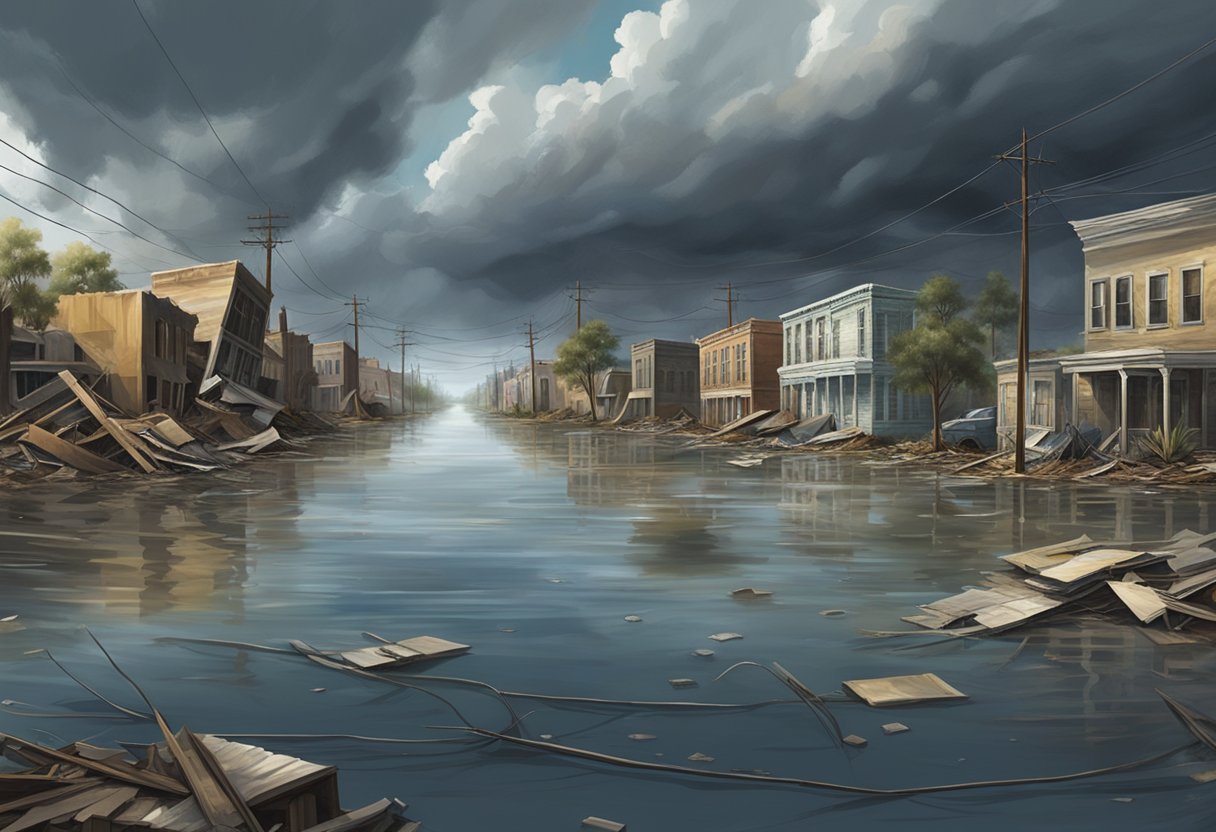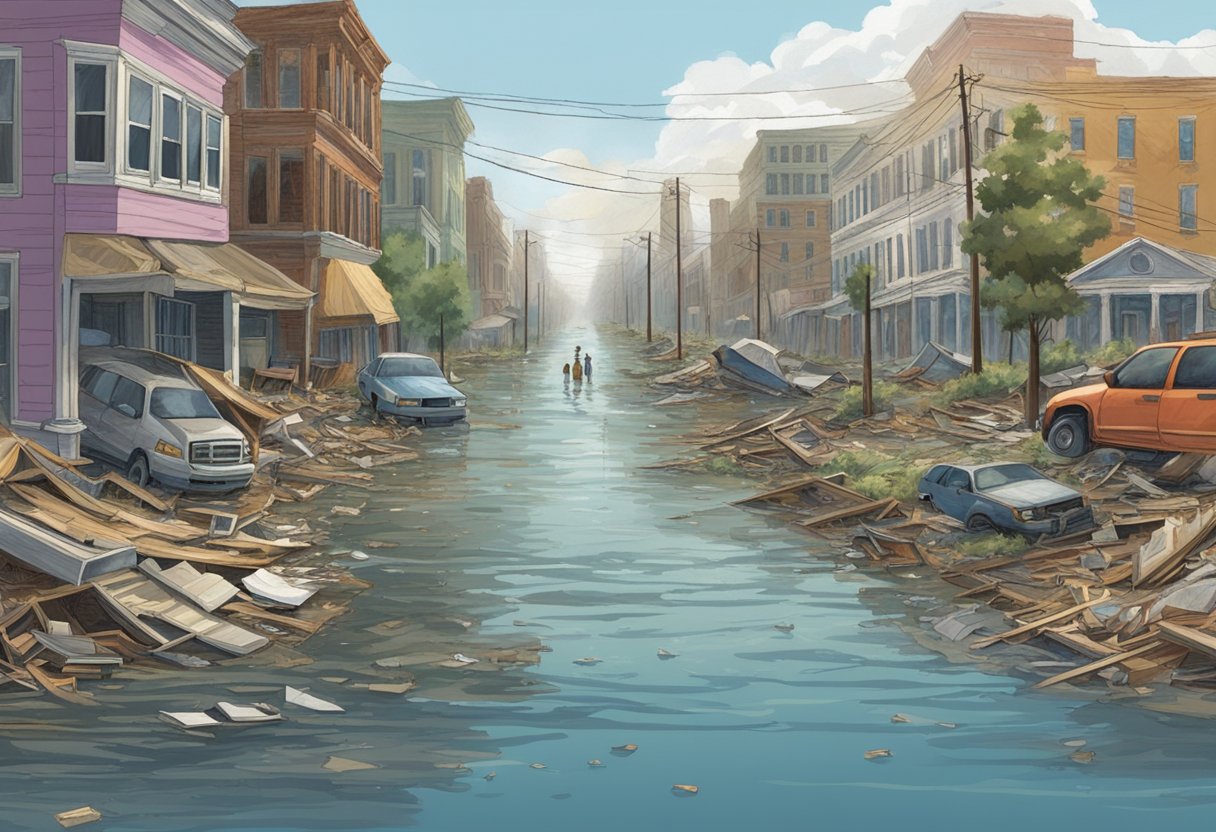Hurricane Katrina: The Disastrous Cost of Unpreparedness and Its Lasting Impact

Hurricane Katrina serves as a stark reminder of the disastrous cost of unpreparedness in the United States. On August 29, 2005, Katrina made landfall, causing widespread devastation across the Gulf Coast, particularly in New Orleans. The hurricane exposed severe flaws in disaster planning and response, leading to massive loss of life, extensive property damage, and a long-lasting effect on the region's economy and infrastructure.
The failure to prepare for such a predictable natural disaster highlighted significant shortcomings in both government and private sector responses. Despite previous warnings and historical data indicating the potential for such catastrophic events, the measures in place were inadequate. The resulting chaos underscored the need for more robust and proactive disaster management strategies.
The aftermath of Hurricane Katrina prompted a national reassessment of disaster preparedness policies and emergency management systems. This tragic event became a catalyst for improvements in how the country handles natural disasters, emphasizing the importance of readiness to mitigate future catastrophes and protect vulnerable communities.
Overview of Hurricane Katrina
Hurricane Katrina was one of the most destructive hurricanes in U.S. history. It began as a tropical depression in the Bahamas, grew into a major hurricane, and caused catastrophic damage along the Gulf Coast, especially in New Orleans.
Formation and Path
Hurricane Katrina formed on August 23, 2005, over the Bahamas. It started as a tropical depression and rapidly intensified over the warm waters of the Gulf of Mexico. On August 25, it hit Florida as a Category 1 hurricane. After crossing Florida, it gained strength over the Gulf of Mexico, reaching Category 5 with winds over 170 mph. On August 29, it made landfall in Louisiana as a Category 3 hurricane.
Classification as a Major Hurricane
Katrina's rapid intensification was due to favorable conditions in the Gulf of Mexico, including warm sea temperatures and low wind shear. By August 28, it had reached Category 5 status. When it made its second landfall in Louisiana, it was a Category 3 hurricane, but still extremely dangerous. Winds were around 120 mph, causing severe damage. The storm's significant strength led to massive storm surges and flooding, especially in New Orleans where the levee system failed.
Impact on the Gulf Coast Regions
The impact of Hurricane Katrina was devastating. New Orleans experienced catastrophic flooding, with approximately 80% of the city underwater. Mississippi and Alabama also faced severe damage from storm surges and high winds. The storm resulted in over 1,800 deaths and displaced hundreds of thousands of people. Damage was estimated at $125 billion, making Katrina one of the costliest natural disasters in U.S. history. The aftermath saw a significant response from federal, state, and local agencies, but many criticized the preparedness and response efforts.
The Unpreparedness of New Orleans

The tragedy of Hurricane Katrina revealed significant flaws in New Orleans' infrastructure and emergency plans. The city's levee system and evacuation strategies were significant points of failure.
Infrastructure and Levee System
New Orleans relied heavily on a complex system of levees and floodwalls designed by the Army Corps of Engineers. These structures were meant to protect the city from flooding. Despite their critical role, many of these levees were inadequately maintained.
- Funding cuts at the federal level left many projects unfinished.
- Local engineers had been debating the system's effectiveness long before Hurricane Katrina.
When Katrina struck, the levees failed to hold back the floodwaters. The breach of these levees led to catastrophic flooding, inundating about 80% of the city. New Orleans' vulnerability was exposed, emphasizing a need for better infrastructure maintenance and stronger flood defenses.
Evacuation and Shelter Strategies
The evacuation strategy for New Orleans was inadequate. While there was a mandatory evacuation order, many residents either couldn't or wouldn't leave. The city lacked a robust plan to ensure everyone, especially the most vulnerable, evacuated safely.
Local government designated places like the Superdome as shelters. Unfortunately, these shelters were quickly overwhelmed. Conditions in the Superdome deteriorated rapidly, lacking basic necessities such as sufficient food, water, and medical care.
Additionally, coordination between local, state, and federal agencies was poor, contributing to the chaos. The result was a disaster response that failed to protect many residents from the storm's impact. Effective evacuation and better-equipped shelters could have significantly reduced the human toll.
Chronology of the Disaster

Hurricane Katrina's history is marked by critical stages, from brewing signs to escalating destruction and finally, rescue and relief operations. Key events are outlined below.
First Signs of the Storm
Hurricane Katrina began forming over the Bahamas on August 23, 2005. Initially, it was a tropical depression but quickly evolved into a strong tropical storm. By August 25, Katrina had reached Category 1 status before making landfall in Florida.
People started feeling the initial effects with heavy rain and strong winds. Reports of flooding and power outages emerged early on. The coast guard and local authorities monitored the storm's progress closely, but few could predict the scale of the disaster that lay ahead.
The Escalation of Conditions
As Katrina moved into the Gulf of Mexico, it intensified dramatically. By August 28, it had escalated to a catastrophic Category 5 hurricane with wind speeds nearing 160 mph. The National Hurricane Center issued severe warnings, urging immediate evacuations.
On August 29, the storm made its final landfall near Buras, Louisiana, as a Category 3 hurricane. The levees in New Orleans breached, leading to massive flooding. Within hours, 80% of New Orleans was submerged. The National Guard and local rescue teams were quickly overwhelmed by the scale of the devastation.
The Aftermath and Rescue Efforts
After the storm passed, the extent of the damage became apparent. Streets turned into rivers, and homes were submerged. Thousands of people were stranded without food or water. The coast guard and national guard conducted search and rescue operations across affected areas.
Temporary shelters were set up in the Superdome and Convention Center, housing those who had not been evacuated. Yet, conditions in these shelters rapidly deteriorated. Federal agencies, along with local resources, struggled to provide timely assistance. Despite heroic efforts, the rescue operations highlighted significant gaps in preparedness and coordination.
Emergency Response and Management

The response to Hurricane Katrina revealed significant lapses and strengths in America's emergency management. The roles taken by FEMA, federal agencies, and local governments highlighted both critical coordination and stark challenges.
Role of FEMA and Federal Agencies
FEMA and other federal agencies were at the forefront of the emergency response. Despite pre-storm preparations, their efforts were often criticized for being slow and inadequate. Michael D. Brown, the Principal Federal Official for Hurricane Katrina, faced scrutiny over the handling of evacuation and relief efforts.
FEMA coordinated with the National Guard and the U.S. Army Corps of Engineers to support rescue missions, security, and infrastructure repairs. Yet, many communities faced delays in receiving aid. Federal authorities had trouble communicating due to the collapsed communication infrastructure, making coordination difficult.
The Department of Homeland Security aimed to oversee these efforts, but there were gaps in execution and preparedness. Subsequent reviews led to recommendations for more efficient emergency management systems and closer federal-local cooperation.
Local Government Actions
Local governments in New Orleans and Mississippi played critical roles in immediate disaster response. Their "bottom-up" approach meant initial responsibility lay with them, but resources and capacity were often insufficient.
Local emergency services, including 911 call centers, were debilitated by the storm. City officials struggled to provide basic services as infrastructure was heavily damaged. Local authorities, despite their proximity to the disaster sites, found it challenging to manage the scope of the catastrophe.
The coordination between local and federal responses was not always seamless. There was confusion over responsibilities and delays in action. The lessons learned called for clearer roles and better-prepared local emergency management systems to handle future disasters.
Consequences of the Disaster

Hurricane Katrina caused severe human suffering and immense economic and environmental damage. The disaster led to significant loss of life, displacement, destruction of homes, and long-term impacts on the affected population.
Humanitarian Impact
Hurricane Katrina resulted in the tragic loss of over 1,800 lives. Many people were displaced, creating a large population of refugees within their own country.
Families were separated, homes were destroyed, and countless people were left without basic necessities. Public health crises emerged as floodwaters and fires wreaked havoc on local infrastructure.
Government aid was slow, leading to widespread poverty. Temporary housing became a pressing issue, with many residents still struggling to find stable living conditions years later.
Economic and Environmental Damage
The economic toll of Hurricane Katrina was staggering, with damage estimates reaching over $125 billion. Major cities, especially New Orleans, faced severe flooding that inundated thousands of homes and businesses.
Rebuilding efforts have been extensive and costly. Local economies were disrupted, leading to job losses and long-term economic challenges for residents. Environmental damage included contaminated floodwaters that harmed wildlife and ecosystems.
Efforts to repair the infrastructure have been ongoing, but many areas still bear the scars of the disaster. The long-term economic viability of these regions has been significantly affected by the hurricane's aftermath.
Analysis and Lessons Learned
Hurricane Katrina exposed critical gaps in emergency preparedness and response. Significant improvements have been made in planning and coordination across various levels of government to address these failures.
Critical Assessment of the Response
The federal response to Hurricane Katrina, led by Michael D. Brown, was widely criticized for its slow and disorganized nature. Many local and state officials were unprepared for the scale of the disaster, and cooperation between all levels of government was inadequate.
Key issues included delayed relief efforts, poor communication, and insufficient supplies. The FEMA struggled to coordinate with local agencies, and there was a lack of clear leadership. Evacuations were not executed effectively, leaving many residents stranded. The response highlighted a significant need for better training and resource allocation.
Improvements in Emergency Preparedness
Since Katrina, there have been notable improvements in emergency planning and response coordination. Federal, state, and local agencies have enhanced their disaster preparedness plans to ensure quicker and more efficient responses. There have been increased efforts in interagency cooperation, improving communication lines and resource sharing.
New policies mandate regular disaster drills and better allocation of emergency supplies. Upgraded technology has improved forecasting and real-time updates. Investments in infrastructure repairs have also been prioritized to withstand future disasters. These changes aim to prevent the severe missteps experienced during Hurricane Katrina. With these enhancements, the nation is now better positioned to tackle similar crises effectively.
Historical Context and Significance
Hurricane Katrina struck the U.S. Gulf Coast in August 2005, bringing with it unprecedented destruction. The hurricane reached Category 5 status with winds peaking at 160 mph, causing catastrophic flooding, especially in New Orleans, Louisiana.
In comparison, historical events like the San Francisco earthquake of 1906 and Hurricane Rita in 2005 illustrate how nature has often tested human preparedness. The earthquake, with a magnitude of 7.9, devastated California, highlighting the impact of natural disasters on urban areas.
Like these events, Hurricane Katrina underscored the high cost of unpreparedness. Many lessons were drawn from these tragedies, emphasizing the importance of disaster planning and infrastructure resilience in the United States. New Orleans, in particular, faced significant challenges due to its location and the failure of levees designed to protect the city from flooding.
Key Points:
- Date: August 2005
- Location: U.S. Gulf Coast, especially New Orleans, Louisiana
- Category: 5
- Wind Speeds: Up to 160 mph
- Comparative Events:
- San Francisco Earthquake (1906): Magnitude 7.9
- Hurricane Rita (2005): Followed Katrina, furthering the strain on Gulf Coast recovery
This event also mirrored the pattern observed in other historical disasters, stressing how predictable events need thorough preparation. Both the earthquake in San Francisco and the hurricanes emphasized the lesson that the cost of prevention is often less than the cost of repairs and loss.
Comparative Perspectives
The impacts of Hurricane Katrina can be better understood by comparing it to other natural disasters and emergency situations. This helps identify key factors in response effectiveness and areas needing improvement.
Similar Natural Disasters
Hurricane Katrina shares key traits with other major natural disasters, such as the 1906 San Francisco earthquake and the more recent Hurricane Rita. Both events caused immense human and economic losses.
The 1906 earthquake resulted in massive fires, just as Katrina led to widespread flooding. Effective preparation could have lessened the damages in both cases. For instance, building codes and disaster preparedness plans could prevent similar devastation.
Tropical storms and cyclones often have patterns allowing for early warnings, yet their aftermath frequently highlights a lack of preparedness. Donations and aid often pour in post-disaster, but these measures frequently appear too late to prevent initial suffering.
Contrasts with Other Emergency Situations
Emergency responses to Katrina contrasted starkly with those to other crises, such as the 9/11 terrorist attacks.
While Katrina had more predictable elements, the response seemed less efficient compared to the more coordinated efforts seen after 9/11. Government and private agencies struggled in Katrina's aftermath, whereas post-9/11 efforts showed greater coordination despite the unexpected nature of the attack.
The lack of effective disaster policy and preparedness plans for natural disasters like hurricanes starkly contrasts with emergency response plans for terror-related events.
Economic losses from Katrina, over $200 billion, highlight this gap in planning and execution. The National Flood Insurance Program and other disaster mitigation plans need enhancement to avoid a replay of past mistakes.
Personal Accounts and Stories
Pauline, the oldest of 11 children, grew up on Mississippi's Gulf Coast. She vividly remembers the chaotic days following Hurricane Katrina in late August 2005. Forced to evacuate, her family faced tough conditions and uncertainty. The storm changed their lives forever.
Douglas P. deSilvey, a native of the Gulf Coast, lived in Gulfport, Mississippi. He and his family endured the storm, overcoming numerous hardships. Douglas recalls how their community banded together in the aftermath, showing resilience and solidarity.
New Orleans' Ninth Ward and Plaquemines Parish witnessed severe destruction. Residents' personal stories reflect both heartache and hope. Many left their homes with only a few belongings, seeking refuge at the Superdome and the New Orleans Convention Center.
A firefighter from the New Orleans Fire Department rescued a young girl trapped in rising waters. This incident highlights the bravery and dedication of the first responders who risked their lives to save others.
The Industrial Canal and 17th Street Canal breaches led to devastating floods in New Orleans. Residents near Lake Pontchartrain and Lake Borgne faced the worst of the surging waters. Personal tales from these areas reveal a mix of fear and courage.
Survivors continue to share their experiences to this day, emphasizing the importance of preparedness and community. These accounts remind us of the human impact behind the headlines and statistics, keeping the memory of Hurricane Katrina's devastation alive.




